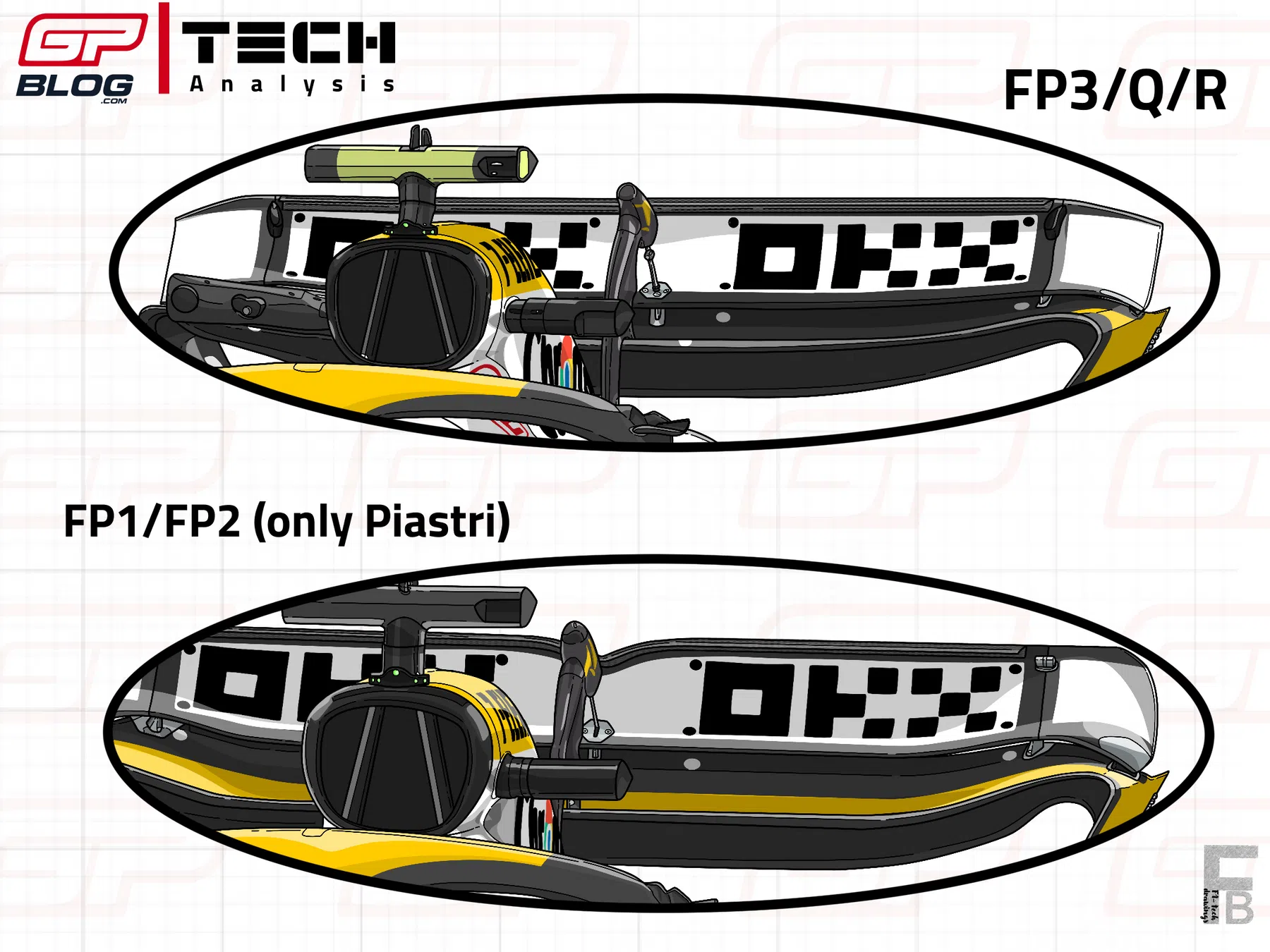Tech Analysis | How McLaren managed with a different rear wing in Singapore
Tech

Lando Norris took advantage of his MCL38's pace, dominating in qualifying and during the race. The McLaren team opted for an unprecedented rear wing in Singapore, but why did they do that?
How the mechanical setup made the MCL38 strong
Since Friday’s FP1, McLaren looked extremely competitive on the Marina Bay Circuit. Especially in Norris’ hands. The team, however, used Friday’s free practices to test two different rear-wing configurations between their drivers. Norris opted for a medium-high downforce rear wing, the same spec used in Zandvoort, while a maximum downforce rear wing was fit on Piastri’s car during both sessions.
As highlighted in the drawing below, the rear wing spec used by Norris showed a different design in both the main plane and the DRS flap. The main plane has a spoon shape, with a more curved leading edge in the central portion and a lower incidence as it approaches the endplate. On the other hand, the version used by Piastri shows a main plane with a very pronounced chord, with a much more accentuated spoon and a straight trend for almost its entire length, showing only a small connection at the lateral ends where it connects to the endplate.
The two specifications also have a different DRS flap: the spec used by Norris has a shorter chord and a straighter trend in the trailing edge, while the version used by Piastri has a much longer chord and, in the central portion, also has the classic "V" cut, adopted in the high-load specifications (this design favours the transition from a high to low-pressure area between the belly and the back of the wing profile, increasing the load produced).
Finally, the two rear wings also differ in terms of the cut in the endplate transition: while the less loaded version adopted by Norris has a more pointed shape aimed at better "fragmenting" the vortices generated by the wing profile and, thus reducing drag, the version adopted by Piastri has a more curvilinear and rounded element in this area, mainly to generate the maximum possible downforce.

The team eventually adopted the same rear wing on both cars from FP3 onwards, which helped the Australian driver, who struggled a lot with the more loaded setup, as he underlined after Saturday’s qualifying: “We've had a few setup differences across the cars for the weekend. We've gradually come closer. […] I think through practice it was a big struggle, to be honest. I just had no pace. I think through qualifying I felt quite comfortable. I was feeling much better with the car, and in Q2, it was strong.”
The situation was quite surprising because Norris's rear wing was, in theory, less suited to the maximum downforce Singapore Circuit, but in reality, it worked better than the spec adopted on Piastri’s car.
But how was that possible? The answer can be found in the mechanical setup of the MCL38. Since the very first few laps, it was clear that McLaren’s engineers found the perfect mechanical setup for their car: the suspension system was kept quite soft, allowing the MCL38 to beautifully absorb all the bumps of the asphalt. This allowed the drivers to be much more aggressive on kerbs than their competitors (during FP3 and qualifying, it was possible to appreciate how much Norris and Piastri were “eating” kerbs compared to Verstappen).
The mechanical softness and the great power provided by the Mercedes engine at low engine revs made the MCL38 a rocket ship in all slow-speed sections and in traction, allowing Norris and Piastri to be unbeatable in all sectors of the track.
Conscious of their superiority from the mechanical side, which would have given them a huge advantage in tyre management, the team decided to give up a bit of aerodynamic grip, using the medium-high downforce rear wing spec explained above, to dominate the straight-line speed. As a consequence, the MCL38 was unmatchable everywhere and was by far the quickest on all compounds.
The two Papaya cars' great performance in Singapore makes the Constructors’ Championship seem even more unattainable for all other top teams. They are expected to bring even more upgrades to the car in the next few rounds. As underlined by Technical Director Rob Marshall on Friday, the team prefers to bring new bits all at the same time, to be sure that they work as expected: “Sometimes you just have to hold on a little bit while you wait for a chunk of bits to come all at the same time. The advantage in doing that is that often bits don't combine very well or as well as you think they would. And if you deliver them in one lump, then that sort of combination of parts has been in CFD together, it was developed together, it's been through a wind tunnel together, so you can be more confident that that combination of bits works well together. Whereas if you do it bit by bit, you might introduce an upgrade on one part and then work on another part and find out actually it's a bit compromised by the previous change you made.”
Consequently, it shouldn’t be surprising to see McLaren take a further step forward once the next package is delivered. This development approach, in contrast to what Ferrari and Red Bull have done this season (especially in Spain, when they rushed their upgrades to test them on track), seems to be the most profitable one, even if it takes much more time, as it ensures that the new parts work perfectly together.

